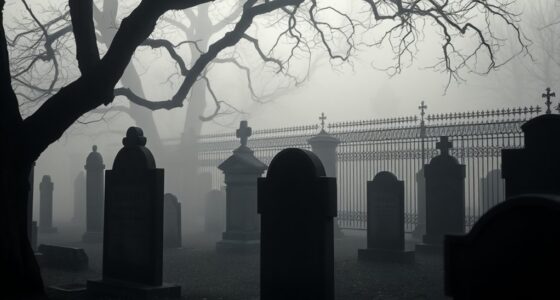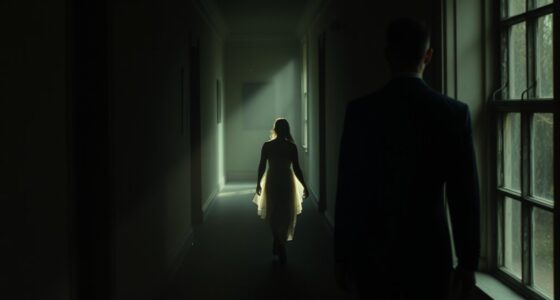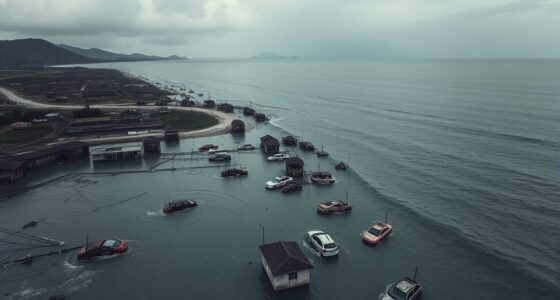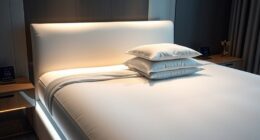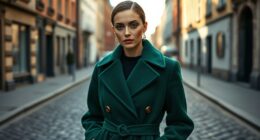The Brown Lady of Raynham Hall photograph, taken in 1936, is widely believed to show a ghostly apparition of Lady Townsend. Using long exposure and traditional photographic tricks like double exposure, the image captures a semi-transparent figure descending the stairs. While some see it as genuine paranormal evidence, skeptics suggest it’s a clever hoax or accidental artifact caused by camera glitches. If you want to uncover what truly lies behind this iconic image, there’s more to explore.
Key Takeaways
- The photograph, taken in 1936, depicts a ghostly figure known as the “Brown Lady,” believed to be Lady Townshend, associated with paranormal legends at Raynham Hall.
- Technical factors like long exposure, double exposure, and camera artifacts likely created the apparition’s semi-transparent appearance.
- Eyewitness accounts and historical records support the story of Lady Townshend’s haunting, reinforcing the image’s paranormal reputation.
- Skeptics attribute the image to photographic errors, manipulation, or natural causes such as dust, reflections, or lens flare.
- Modern analyses suggest possible photographic tricks, but the image remains an iconic symbol of ghost lore, maintaining its mystique.
The Origins of the Raynham Hall Photograph

The origins of the Raynham Hall photograph trace back to 1936, when British photographer Captain Hubert C. was hired to take photos of Raynham Hall for a magazine feature. During the shoot, he and his assistant noticed a strange, misty figure descending the staircase. Although they dismissed it as a trick of the light or a reflection, the image captured on film seemed hauntingly real. The photograph was developed and shared with the magazine, which published it shortly after. From that moment, the image gained notoriety as the “Brown Lady,” fueling stories of a ghostly presence. Your curiosity might lead you to wonder whether the photo was staged or genuinely supernatural, but its mysterious origins remain a compelling part of paranormal folklore. Interestingly, some experts suggest that optical illusions like reflections or shadows could account for such eerie images.
The Details of the 1936 Photo Session
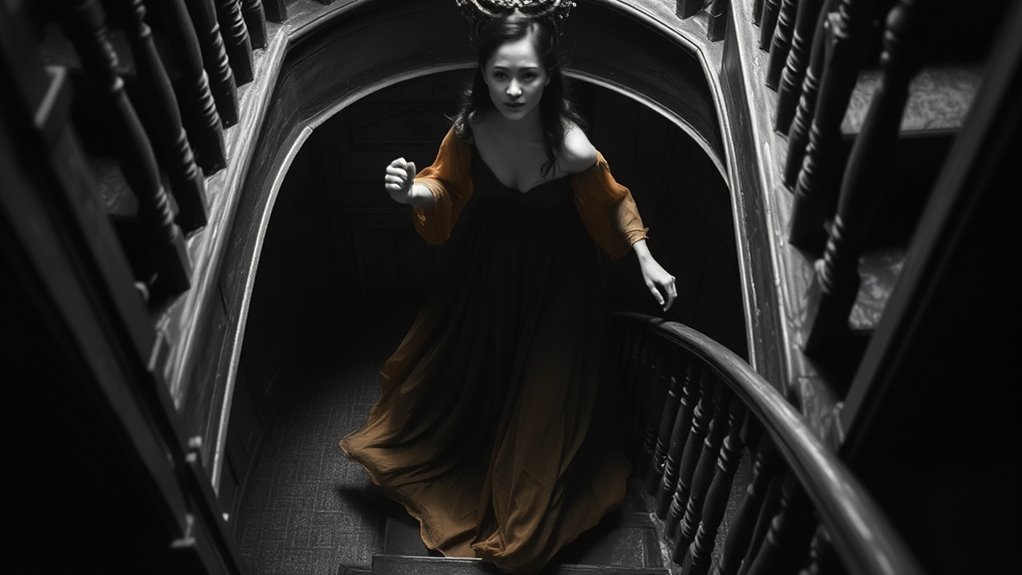
During the 1936 photo session at Raynham Hall, Captain Hubert C. and his assistant set up their equipment in the grand staircase area, enthusiastic to capture the estate’s historic ambiance. They arranged their camera on a tripod, adjusting the focus and lighting carefully. As they prepared, the atmosphere grew tense with anticipation. You notice they took multiple shots, making sure every detail was perfect. They used a large-format camera, which required long exposures, making stability vital. The camera setup was meticulously planned to ensure sharp images and minimal motion blur.
Analyzing the Image: Features and Details
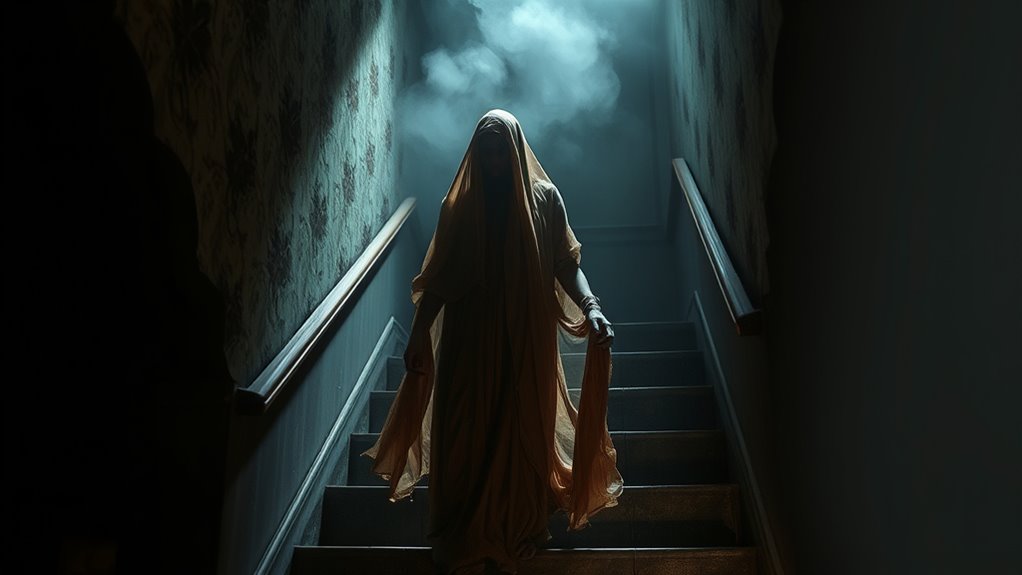
As you examine the image, notice the ghostly apparition’s distinct traits, like its translucent form and flowing robes. Pay attention to any photographic anomalies or artifacts that might influence how the image appears. These features can reveal whether the photo captures something genuine or if it’s a product of technical factors or manipulation. Additionally, understanding photo editing techniques can help differentiate between authentic images and digital alterations.
Apparition’s Visual Traits
Upon examining the famous photograph of the Brown Lady, you notice an ethereal, semi-transparent figure cloaked in what appears to be a flowing, dark gown. The apparition’s visual traits include a faint, glowing outline that emphasizes its ghostly presence. Its face seems obscured, adding mystery and ambiguity. You observe the figure’s posture, which appears stiff yet serene, reinforcing its spectral nature. The gown’s flowing texture suggests movement, as if caught in an unseen breeze. Details such as the figure’s elongated fingers and the vague suggestion of a crown or headdress contribute to its haunting appearance. Understanding the visual traits of ghostly apparitions can help differentiate between genuine spectral phenomena and optical illusions or photographic artifacts.
Photographic Anomalies and Artifacts
Analyzing the photograph reveals several anomalies and artifacts that raise questions about its authenticity. You notice strange blurs, unexpected light spots, and inconsistent shadows that seem out of place. These irregularities might result from film defects or digital manipulation. For example, ghostly outlines can appear due to double exposure or long exposure errors. To better understand these features, examine the table below:
| Anomaly/Artifact | Possible Explanation |
|---|---|
| Blurred figure | Long exposure or movement during shot |
| Light spots or orbs | Dust, insects, or lens flare |
| Inconsistent shadows | Editing or double exposure |
| Semi-transparent areas | Overexposure or digital editing |
| Unnatural outlines | Composite images or artifacts |
These elements suggest the image’s credibility may be compromised by technical issues or deliberate manipulation. Additionally, understanding common photographic anomalies can help in evaluating such images more critically.
Theories Supporting the Photograph’s Authenticity

You may find that historical documents mention the Brown Lady’s presence, lending credibility to the photo. Examining the photographic evidence reveals techniques consistent with the era, supporting its authenticity. Eyewitness testimonies from those who saw the hall’s ghostly figure add further weight to the idea that the photograph is genuine. Additionally, historical records about the Brown Lady reinforce the longstanding belief in her existence.
Historical Documentation Support
Supporters of the Brown Lady photograph point to various historical records that lend credibility to its authenticity. These documents include eyewitness accounts, estate records, and reports from early visitors. For example, there are detailed descriptions of Lady Townshend’s death and her subsequent hauntings, which match the figure in the photograph. Additionally, estate inventories mention a mysterious, ghostly presence in Raynham Hall. Some supporters highlight correspondence from visitors who claimed to see or photograph the apparition. Others cite police reports or journal entries referencing strange sightings. Finally, historical timelines align with the period when the photograph was taken, strengthening the case that the image captures a real, documented phenomenon rather than a hoax or trick.
Photographic Evidence Analysis
Proponents argue that the Brown Lady photograph displays genuine paranormal activity due to its consistent visual anomalies, such as the semi-transparent, floating figure that appears to fade in and out of focus. They point out that the ghostly image’s clarity, despite the era’s photographic limitations, suggests it’s not a mere double exposure or trick. Supporters also cite the photograph’s detailed features, like the flowing gown and the distinct shape, which are hard to replicate artificially. The table below summarizes key points supporting authenticity:
| Feature | Explanation | Significance |
|---|---|---|
| Semi-transparency | Mimics ghostly translucency | Unlikely to be faked easily |
| Consistent appearance | Repeats in multiple copies | Supports genuine phenomenon |
| Fading effect | Fades naturally in some prints | Adds to paranormal impression |
| Historical context | Taken at a time of limited photographic tricks | Enhances credibility |
| Lack of obvious manipulation | No signs of tampering in original print | Strengthens authenticity |
Additionally, the photograph’s photographic limitations during the time period make it difficult to dismiss as a modern fake.
Eyewitness Testimonies
Could eyewitness accounts be the key to confirming the authenticity of the Brown Lady photograph? Many believe that firsthand reports support its legitimacy. You might find it compelling that several witnesses have claimed to see the ghostly figure around Raynham Hall, especially near the staircase. Some have reported feeling cold spots or uneasy sensations when the apparition appears. Others describe hearing unexplained footsteps or whispers during the night. A few eyewitnesses have even noted seeing a translucent woman in period clothing, matching the woman in the photo. These accounts, while subjective, add weight to the idea that the photograph captures a real paranormal presence, not just a clever hoax. Eyewitness testimonies help bridge the gap between photographic evidence and local legend. Additionally, many believe that paranormal activity at Raynham Hall is supported by historical reports of unexplained occurrences in the estate.
Skeptical Explanations and Debunking Efforts
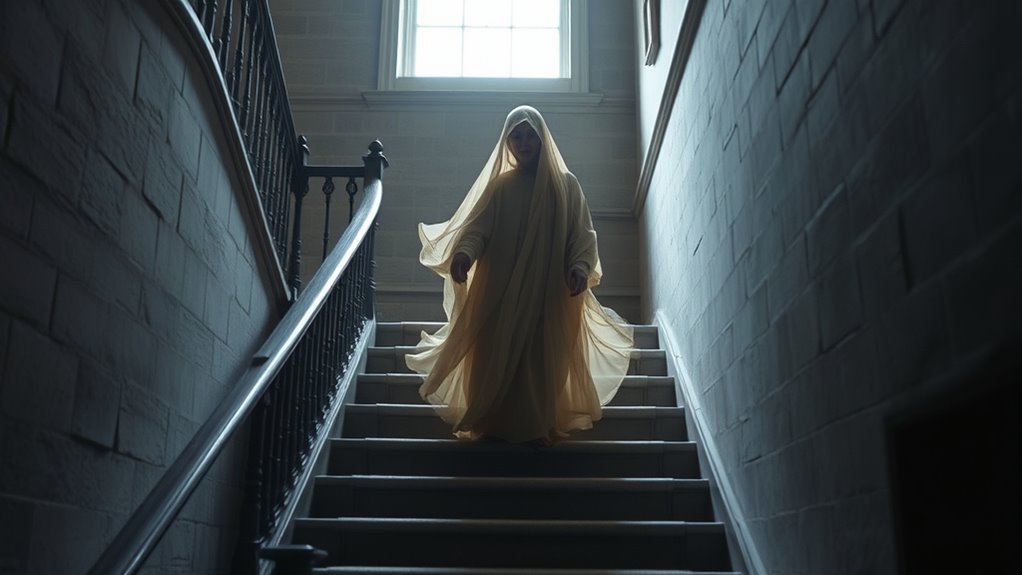
Many skeptics argue that the famous photograph of the Brown Lady is simply a case of photographic manipulation or accidental exposure. They believe the image was either edited or captured through a mistake in camera settings, like long exposure or light leaks. To illustrate, consider this table:
| Explanation | Evidence | Counterpoint |
|---|---|---|
| Double exposure | Common in early photography | No clear signs of merging images |
| Light leak | Camera imperfections | Not consistent across copies |
| Hoax or manipulation | Digital editing claims | No definitive proof |
| Long exposure | Blurred figure in photo | Inconsistent with known techniques |
| Reflection or glare | Light reflections from nearby objects | Unlikely given the scene |
These efforts aim to cast doubt on the paranormal claims surrounding the image, emphasizing natural or technical causes instead. Additionally, understanding photographic techniques can help clarify how such images might be produced unintentionally.
The Role of Photography Techniques and Tricks

Photography techniques and tricks can easily create illusions that make a photograph appear paranormal, even when no supernatural presence is involved. You can manipulate lighting, angles, and exposure settings to produce ghostly effects. For example, long exposures can blur movement, making figures appear transparent or ethereal. Double exposure techniques overlay two images, creating ghost-like apparitions. Shadows and reflections can be strategically used to suggest a presence that isn’t there. Additionally, props and costumes can enhance the illusion, while digital editing can add or alter features. Understanding layer concepts can help in organizing and planning these photographic effects effectively.
Cultural Impact and Public Reception

The Brown Lady of Raynham Hall photograph has become an enduring icon that deeply influences popular perceptions of the supernatural. It sparks curiosity and fuels ghost stories worldwide. People often associate it with haunted places and unexplained phenomena, shaping cultural narratives about spirits. The image has inspired books, movies, and folklore, cementing its place in ghost lore. Its mystery invites skepticism and belief alike, igniting debates about the existence of ghosts.
| Imaginary Scene | Vivid Description |
|---|---|
| Haunted Hallway | Dimly lit, echoing footsteps |
| Ghostly Figure | Faint, translucent silhouette |
| Candlelight | Flickering shadows on the wall |
| Whispering Voices | Echoes in the silent rooms |
Ongoing Investigations and Modern Perspectives
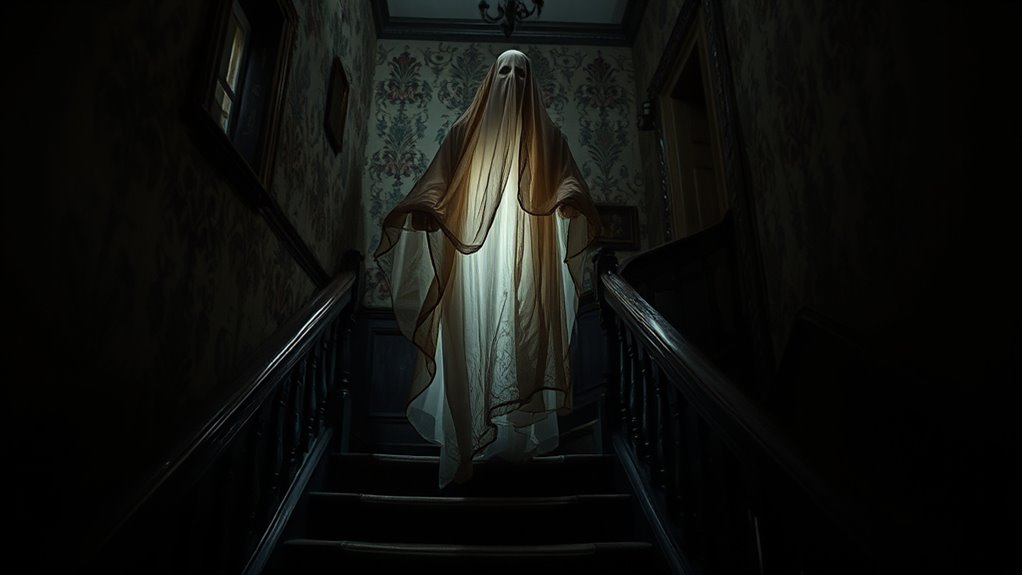
Have modern investigations shed new light on the Brown Lady photograph? Recent advances in technology and research methods have sparked fresh debates. Experts now analyze the image through digital enhancement, 3D modeling, and forensic techniques to determine authenticity. Some findings suggest it could be a double exposure or a trick of the light, while others believe it remains unexplained. Here are some key points:
- Digital image analysis reveals possible signs of manipulation
- Forensic studies explore the photograph’s origin
- Historical research uncovers new details about Raynham Hall
- Expert opinions vary on whether it’s a ghost or a hoax
- Advances in ghost photography challenge previous skepticism
These ongoing investigations keep the mystery alive, encouraging both skeptics and believers to seek answers using modern tools. The debate continues, blending history, technology, and paranormal intrigue.
Frequently Asked Questions
Has Anyone Claimed to See the Lady in Person Since the Photo?
Yes, some people claim to have seen the Brown Lady in person over the years. Visitors and staff at Raynham Hall report unexplained sightings, often feeling a cold chill or sensing a presence in the same spots where the famous photo was taken. Although these accounts are anecdotal, they keep the legend alive and intrigue those who visit, hoping to catch a glimpse of the ghostly figure themselves.
Are There Any Verified Eyewitness Accounts Besides the Photograph?
You’ll find that verified eyewitness accounts beyond the famous photo are extremely rare, with only a handful reported over the years. Remarkably, some visitors claim to have seen a faint, misty figure matching the Brown Lady’s description, especially during foggy nights or in low-light conditions. While these sightings aren’t officially verified, they add to the eerie legend, making the story even more enthralling for those interested in paranormal phenomena.
What Are the Most Common Alternative Explanations for the Apparition?
You might consider that the apparition is caused by optical illusions, like light reflections or shadows, especially in low-light conditions. Others believe it could be a case of pareidolia, where your mind interprets vague shapes as faces or figures. Some suggest it’s a hoax or accidental double exposure in the photograph. Skeptics argue that natural phenomena or camera artifacts explain the haunting image rather than a genuine ghostly apparition.
How Has the Photograph Influenced Ghost-Hunting Practices?
You might think the Brown Lady photo is just a spooky image, but it actually transformed ghost-hunting practices. It pushed enthusiasts to adopt more systematic, evidence-based methods, like using advanced cameras and infrared technology. You’ll find that it encouraged skeptics and believers alike to approach paranormal investigations with greater rigor. This iconic photo made ghost-hunting less about folklore and more about scientific exploration, shaping how you and others seek proof of the supernatural today.
Are There Similar Ghost Photographs From Other Historic Sites?
Yes, there are similar ghost photographs from other historic sites. You might encounter images from places like the Tower of London or the Winchester Mystery House, where unexplained figures or orbs appear in photos. These images often fuel debates about the supernatural and inspire ghost-hunting enthusiasts. You can explore these photographs online or during ghost tours, adding to your fascination with paranormal phenomena at historic locations.
Conclusion
You seek truth, you question legend, you explore mystery. You analyze details, you weigh evidence, you consider theories. You embrace curiosity, challenge skepticism, and wonder if the Brown Lady’s ghostly image is authentic or illusion. In this quest, you uncover stories, decipher tricks, and reflect on belief. Ultimately, you decide—believe or doubt, accept or reject—the mystery remains yours to unravel, forever enthralling your mind and fueling your imagination.


